Students must practice this TS Intermediate Maths 2B Solutions Chapter 1 Circle Ex 1(d) to find a better approach to solving the problems.
TS Inter 2nd Year Maths 2B Solutions Chapter 1 Circle Exercise 1(d)
I.
Question 1.
Find the condition that the tangents are drawn from (0, 0) to S ≡ x2 + y2 + 2gx + 2fy + c = 0 be perpendicular to each other.
Solution:
If the angle between the tangents drawn from P(x1, y1) to S = 0 is θ then
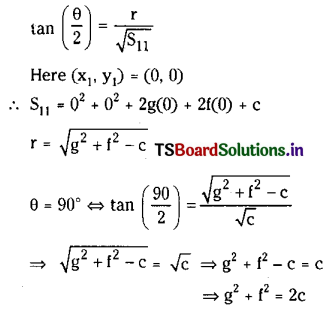
Question 2.
Find the chord of contact of (0, 5) with respect to the circle x2 + y2 – 5x + 4y – 2 = 0.
Solution:
Comparing with x2 + y2 + 2gx + 2fy + c = 0,
we get g = \(-\frac{5}{2}\), f = 2, c = -2
∴ Equation of chord of contact of (x1, y1) w.r.t S = 0 is xx1 + yy1 + g(x + x1) + f(y + y1) + c = 0
∴ The equation of chord of contact of (0, 5) w.r.t. x2 + y2 – 5x + 4y – 2 = 0 is x(0) + y(5) + \(\left(\frac{-5}{2}\right)\) (x + 0) + 2(y + 5) – 2 = 0
⇒ 5y – \(\frac{5 x}{2}\) + 2y + 10 – 2 = 0
⇒ 5y – \(\frac{5 x}{2}\) + 2y + 8 = 0
⇒ 10y – 5x + 4y + 16 = 0
⇒ -5x + 14y + 16 = 0
⇒ 5x – 14y – 16 = 0
![]()
Question 3.
Find the chord of contact of (1, 1) to the circle x2 + y2 = 9.
Solution:
Equation of chord of contact of (x1, y1) w.r.t x2 + y2 = a2 is xx1 + yy1 – a2 = 0.
∴ The equation of chord of contact of (1, 1) w.r.t x2 + y2 = 9 is x(1) + y(1) – 9 = 0
⇒ x + y – 9 = 0
Question 4.
Find the polar of (1, 2) with respect to x2 + y2 = 7.
Solution:
Equation of polar of (x1, y1) with respect to x2 + y2 = a2 is xx1 + yy1 – 9 = 0.
∴ The equation of polar of (1, 2) with respect to x2 + y2 = 7 is x(1) + y(2) – 7 = 0
⇒ x + 2y – 7 = 0
Question 5.
Find the polar of (3, -1) with respect to the circle 2x2 + 2y2 = 11.
Solution:
Given equation of circle is x2 + y2 = \(\frac{11}{2}\)
∴ Equation of polar of (x1, y1) w.r.t x2 + y2 = a2 is xx1 + yy1 – a2 = 0.
⇒ x(3) + y(-1) – \(\frac{11}{2}\) = 0
⇒ 6x – 2y – 11 = 0
Question 6.
Find the polar of (1, -2) with respect to x2 + y2 – 10x – 10y + 25 = 0.
Solution:
Polar of (x1, y1) w.r.t x2 + y2 + 2gx + 2fy + c = 0 is xx1 + yy1 + g(x + x1) + f(y + y1) + c = 0
⇒ x(1) + y(-2) – 5(x + 1) – 5(y – 2) + 25 = 0
⇒ -4x – 7y + 30 = 0
⇒ 4x + 7y – 30 = 0
![]()
Question 7.
Find the pole of ax + by + c = 0 (c ≠ 0) w.r.t x2 + y2 = r2
Solution:
Let (x1, y1) be the pole of ax + by + c = 0 ……(1) w.r.t. x2 + y2 = r2; then the equation of polar is xx1 + yy1 – r2 = 0 ……….(2)
∴ From (1) and (2)
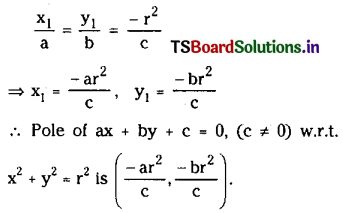
Question 8.
Find the pole of 3x + 4y – 45 = 0 w.r.t x2 + y2 – 6x – 8y + 5 = 0
Solution:
Let (x1, y1) be the pole of 3x + 4y – 45 = 0 ………(1)
Then the equation of polar of (x1, y1) w.r.t the circle x2 + y2 – 6x – 8y + 5 = 0 is xx1 + yy1 – 3(x + x1) – 4(y + y1) + 5 = 0
⇒ x(x1 – 3) + y(y1 – 4) – (3x1 + 4y1 – 5) = 0 ……….(2)
∴ From (1) and (2)
\(\frac{x_1-3}{3}=\frac{y_1-4}{4}=\frac{-\left(3 x_1+4 y_1-5\right)}{-45}\)
⇒ \(\frac{x_1-3}{3}=\frac{y_1-4}{4}\)
⇒ 4x1 – 12 = 3y1 – 12
⇒ 4x1 – 3y1 = 0 ……….(3)
\(\frac{y_1-4}{4}=\frac{3 x_1+4 y_1-5}{45}\)
⇒ 45y1 – 180 = 12x1 + 16y1 – 20
⇒ 12x1 – 29y1 + 160 = 0 ………(4)
Solving (3) and (4) we get
12x1 – 9y1 = 0
12x1 – 29y1 = -160
∴ 20y1 = 160
⇒ y1 = 8
and from (3)
4x1 = 24
⇒ x1 = 6
∴ Pole of 3x + 4y – 45 = 0 w.r.t x2 + y2 – 6x – 8y + 5 = 0 is (6, 8).
Question 9.
Find the pole of x – 2y + 22 = 0 w.r.t x2 + y2 – 5x + 8y + 6 = 0.
Solution:
Let (x1, y1) be the pole of the line x – 2y + 22 = 0 ………(1)
Then the equation of polar of (x1, y1) w.r.t circle x2 + y2 – 5x + 8y + 6 = 0 ………(2) is
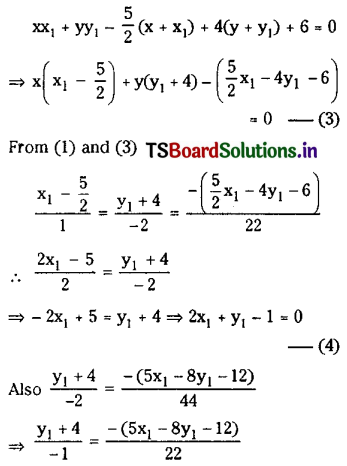
⇒ 22y1 + 88 = 5x1 – 8y1 – 12
⇒ 5x1 – 30y1 – 100 = 0
⇒ x1 – 6y1 – 20 = 0 ………(5)
∴ 2x1 – 12y1 – 40 = 0 and 2x1 + y1 – 1 = 0
solving -13y1 – 39 = 0 ⇒ y1 = -3
and from (4), 2x1 – 3 – 1 = 0 ⇒ x1 = 2
pole of x – 2y + 22 = 0 w.r.t. x2 + y2 – 5x + 8y + 6 = 0 is (2, -3).
Question 10.
Show that the points (-6, 1) and (2, 3) are conjugate points w.r.t the circle x2 + y2 – 2x + 2y + 1 = 0.
Solution:
Let P(-6, 1) and Q(2, 3) be the given points.
Two points P(x1, y1) and Q(x2, y2) one said to be conjugate
⇔ S12 = 0
⇔ x1x2 + y1y2 + g(x1 + x2) + f(y1 + y2) + c = 0
∴ S12 = (-6)(2) + (1)(3) – 1(-6 + 2) + 1(1 + 3) + 1
= -12 + 3 + 4 + 4 + 1
= 0
∴ Hence the points P and Q are conjugate w.r.t. the given circle.
![]()
Question 11.
Show that the points (4, 2) and (3, -5) are conjugate points w.r.t the circle x2 + y2 – 3x – 5y + 1 = 0.
Solution:
Let P(x1, y1) = (4, 2) and Q(x2, y2) = (3, -5)
Now S12 = x1x2 + y1y2 + g(x1 + x2) + f(y1 + y2) + c = 0
= (4)(3) + (2)(-5) – \(\frac{3}{2}\)(4 + 3) – \(\frac{5}{2}\)(2 – 5) + 1
= 12 – 10 – \(\frac{21}{2}+\frac{15}{2}\) + 1 = 0
= 24 – 20 – 21 + 15 + 2
= 0
Hence the points P and Q are conjugate w.r.t. the given circle.
Question 12.
Find the value of k if kx + 3y – 1 = 0, 2x + y + 5 = 0 are conjugate lines w.r.t the x2 + y2 – 2x – 4y – 4 = 0.
Solution:
Two lines l1x + m1y + n1 = 0 and l2x + m2y + n2 = 0 are said to be conjugate w.r.t. x2 + y2 + 2gx + 2fy + c = 0.
If r2(l1l2 + m1m2) = (l1g + m1f – n1) (l2g + m2f – n2)
Here g = -1, f = -2,
r = \(\sqrt{\mathrm{g}^2+\mathrm{f}^2-\mathrm{c}}=\sqrt{1+4+4}\) = 3
l1 = k, m1 = 3, n1 = -1, l2 = 2, m22 = 1, n2 = 5
∴ r2(l1l2 + m1m2) = 9(2k + 3)
and (l1g + m1f – n1) (l2g + m2f – n2) = (-k – 6 + 1) (-2 – 2 – 5) = (-k – 5) (-9)
∴ 9(2k + 3) = 9(k + 5)
⇒ 2k + 3 = k + 5
⇒ k – 2 = 0
⇒ k = 2
Question 13.
Find the value of k if x + y – 5 = 0, 2x + ky – 8 = 0 are conjugate w.r.t the circle x2 + y2 – 2x – 2y – 1 = 0.
Solution:
Comparing the given equation of circle with x2 + y2 + 2gx + 2fy + c = 0,
we have g = -1, f = -1, c = -1 and
radius = \(\sqrt{\mathrm{g}^2+\mathrm{f}^2-\mathrm{c}}=\sqrt{1+1+1}=\sqrt{3}\)
Condition for two lines l1x + m1y + n1 = 0 and l2x + m2y + n2 = 0 to be conjugate w.r.t. S = 0
r2 (l1l2 + m1m2) = (l1g + m1f – n1) (l2g + m2f – n2)
Given that the equations of lines are x + y – 5 = 0 and 2x + ky – 8 = 0
l1 = 1, m1 = 1, n1 = -5, l2 = 2, m2 = k, n2 = -8
∴ r2(l1l2 + m1m2) = 3(2 + k) and (l1g + m1f – n1) (l2g + m2f – n2) = (-1 – 1 + 5) (-2 – k + 8)
∴ 3(2 + k) = 3(6 – k) = 18 – 3k
⇒ 6 + 3k = 18 – 3k
⇒ 6k = 12
⇒ k = 2
Question 14.
Find the value of k if the points (1, 3) and (2, k) are conjugate w.r.t the circle x2 + y2 = 35.
Solution:
The condition for two points P(x1, y1) and Q(x2, y2) to be conjugate w.r.t x2 + y2 = a2 is x1x2 + y1y2 – a2 = 0
Given P(x1, y1) = (1, 3) and Q(x2, y2) = (2, k) and a2 = 35.
∴ x1x2 + y1y2 – a2 = 2 + 3k – 35
⇒ 3k – 33 = 0
⇒ k = 11
![]()
Question 15.
Find the value of k if the points (4, 2), (k, -3) are conjugate points w.r.t the circle x2 + y2 – 5x + 8y + 6 = 0.
Solution:
Two points P(x1, y1) and Q(x2, y2) are said to be conjugate w.r.t the circle S = 0 if S12 = 0.
i.e., x1x2 + y1y2 + g(x1 + x2) + f(y1 + y2) + c = 0
Given P(x1, y1) = (4, 2) and Q(x2, y2) = (k, -3)
Then S12 = 4k – 6 – \(\frac{5}{2}\)(4 + k) + 4(2 – 3) + 6 = 0
⇒ 4k – 6 – \(\frac{5}{2}\)(4 + k) – 4 + 6 = 0
⇒ 4k – \(\frac{5}{2}\)(4 + k) – 4 = 0
⇒ 4k – 10 – \(\frac{5k}{2}\) – 4 = 0
⇒ 8k – 20 – 5k – 8 = 0
⇒ 3k – 28 = 0
⇒ k = \(\frac{28}{3}\)
II.
Question 1.
Find the angle between the tangents drawn from (3, 2) to the circle x2 + y2 – 6x + 4y – 2 = 0. (Mar. ’12)
Solution:
If θ is the acute angle between the tangents drawn from P(3, 2) to the circle S = 0 then
cos θ = \(\left|\frac{s_{11}-r^2}{s_{11}+r^2}\right|\) where r is the radius of the circle.
Where S11 = \(x_1^2+y_1^2\) + 2gx1 + 2fy1 + c
= 9 + 4 – 6(3) + 4(2) – 2
= 1
and r = radius of the given circle = \(\sqrt{9+4+2}=\sqrt{15}\)
∴ cos θ = \(\left|\frac{1-15}{1+15}\right|=\left|\frac{-14}{16}\right|=\frac{7}{8}\)
∴ θ = \({Cos}^{-1} \cdot\left(\frac{7}{8}\right)\)
∴ The angle between tangents drawn from (3, 2) to the given circle is \({Cos}^{-1} \cdot\left(\frac{7}{8}\right)\).
Question 2.
Find the angle between the pair of tangents drawn from (1, 3) to the circle x2 + y2 – 2x + 4y – 11 = 0.
Solution:
If θ is the acute angle between the tangents drawn from P(3, 2) to the circle S = 0 then
cos θ = \(\left|\frac{s_{11}-r^2}{s_{11}+r^2}\right|\) where r is the radius of the circle.
S11 = \(x_1^2+y_1^2\) + 2gx1 + 2fy1 + c
= 1 + 9 – 2 + 12 – 11
= 9
and r = radius of the given circle (r) = \(\sqrt{1+4+11}\) = 4
∴ cos θ = \(\left|\frac{9-16}{9+16}\right|=\left|\frac{7}{25}\right|\)
∴ θ = \({Cos}^{-1}\left(\frac{7}{25}\right)\)
∴ The angle between the pair of tangents drawn from (1, 3) to the circle x2 + y2 – 2x + 4y – 11 = 0 is \({Cos}^{-1}\left(\frac{7}{25}\right)\)
![]()
Question 3.
Find the angle between the pair of tangents drawn from (0, 0) to the circle x2 + y2 – 14x + 2y + 25 = 0.
Solution:
If θ is the angle between the tangents drawn from O(0, 0) to the circle S = 0 then
cos θ = \(\left|\frac{s_{11}-r^2}{s_{11}+r^2}\right|\)
where S11 = \(\mathrm{x}_1^2+\mathrm{y}_1^2\) + 2gx1 + 2fy1 + c
= 0 + 0 + 0 + 0 + 25
= 25
and r = \(\sqrt{49+1-25}\) = 5
∴ cos θ = \(\left|\frac{25-25}{25+5}\right|\) = 0
∴ θ = \(\frac{\pi}{2}\)
∴ The angle between the pair of tangents drawn from (0, 0) to the given circle is \(\frac{\pi}{2}\).
Question 4.
Find the locus of P if the tangents drawn from P to x2 + y2 = a2 include an angle α.
Solution:
The centre of the circle x2 + y2 = a2 is C = (0, 0) and radius = a
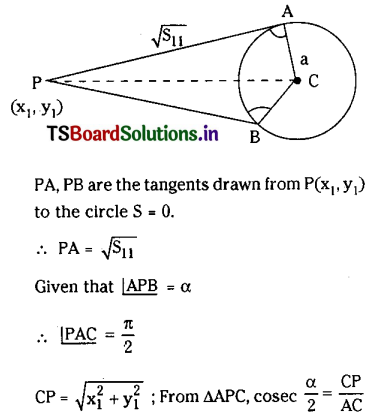
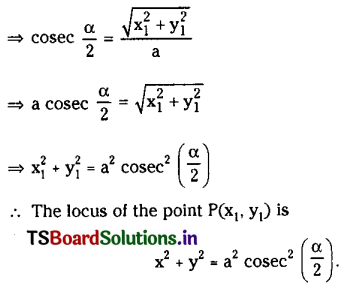
Question 5.
Find the locus of P if the tangents drawn from P to x2 + y2 = a2 are perpendicular to each other.
Solution:
Equation of the given circle is x2 + y2 = a2 and radius = a
Let P(x1, y1) be any point on the locus.
Since the tangents drawn from P(x1, y1) to the circle are perpendicular to each other,
the angle between tangents is \(\frac{\pi}{2}\)
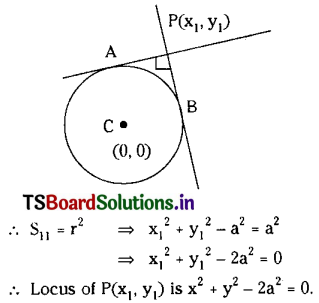
Question 6.
Find the slope of the polar of (1, 3) with respect to the circle x2 + y2 – 4x – 4y – 4 = 0. Also, find the distance from the centre to it.
Solution:
Equation of polar of the point P(x1, y1) w.r.t circle S ≡ x2 + y2 + 2gx + 2fy + c = 0 is xx1 + yy1 + g(x + x1) + f(y + y1) + c = 0
∴ Polar of (1, 3) w.r.t. circle x2 + y2 – 4x – 4y – 4 = 0 is x(1) + y(3) – 2(x + 1) – 2(y + 3) – 4 = 0
⇒ -x + y – 12 = 0
⇒ x – y + 12 = 0
∴ The slope of the polar is ‘1’
Also, the distance from the centre (2, 2) to the polar of (1, 3) i.e., x – y + 12 = 0 is \(\left|\frac{2-2+12}{\sqrt{1+1}}\right|=\frac{12}{\sqrt{2}}=6 \sqrt{2}\)
![]()
Question 7.
If ax + by + c = 0 is a polar of (1, 1) w.r.t the circle x2 + y2 – 2x + 2y + 1 = 0 and H.C.F of a, b, c is equal to one then find a2 + b2 + c2.
Solution:
Equation of polar of (1, 1) w.r.t the circle x2 + y2 – 2x + 2y + 1 = 0 is x(1) + y(1) – 1(x + 1) + 1(y + 1) + 1 = 0
⇒ 2y + 1 = 0 ……….(1)
Given that polar of P(1, 1) is ax + by + c = 0 ………(2)
since (1) and (2) represent the same line
\(\frac{\mathrm{a}}{0}=\frac{\mathrm{b}}{2}=\frac{\mathrm{c}}{1}=\mathrm{k}\)
⇒ a = 0, b = 2k, c = k
Given that H.C.F of a, b, c is ‘1’ we have k = 1
∴ a = 0, b = 2, c = 1
∴ a2 + b2 + c2 = 0 + 4 + 1 = 5
III.
Question 1.
Find the coordinates of the point of intersection of tangents at the points where x + 4y – 14 = 0 meets the circle x2 + y2 – 2x + 3y – 5 = 0.
Solution:
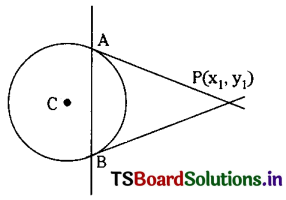
Let P(x1, y1) be the point of intersection of tangents drawn to the circle x2 + y2 – 2x + 3y – 5 = 0 …………(1) and given that x + 4y – 14 = 0 ………..(2) meets the circle at points A, B.
∴ Equation of chord of contact of (x1, y1) w.r.t circle (1) is xx1 + yy1 – (x + x1) + \(\frac{3}{2}\)(y + y1) – 5 = 0
⇒ \(x\left(x_1-1\right)+y\left(y_1+\frac{3}{2}\right)-\left(x_1-\frac{3}{2} y_1+5\right)=0\) …….(3)
Since (2) and (3) represent the same chord of contact
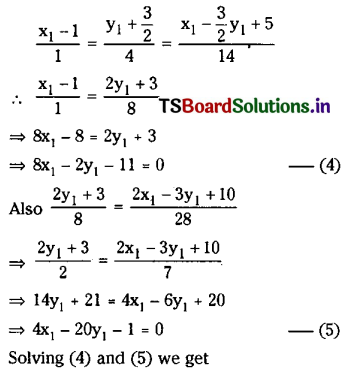
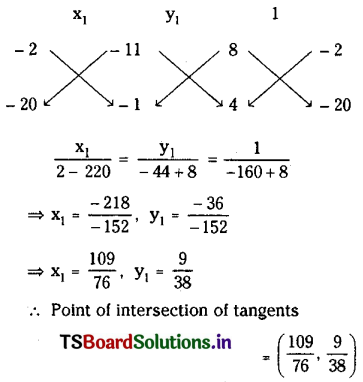
Question 2.
If the polar of the points on the circle x2 + y2 = a2 w.r.t the circle x2 + y2 = b2 touches the circle x2 + y2 = c2 then prove that a, b, c are in geometrical progression.
Solution:
Given equations of circles
x2 + y2 = a2 …….(1)
x2 + y2 = b2 …….(2)
x2 + y2 = c2 ……(3)
Let P(x1, y1) be any point on (1) then
\(x_1^2+y_1^2\) = a2 ………(4)
The equation of polar of P(x1, y1) w.r.t circle (2) is xx1 + yy1 – b2 = 0 ……..(5)
The Centre of (3) is (0, 0), and the radius = c.
Given that line (5) is polar of P w.r.t the circle (2) which touches the circle (3).
∴ The perpendicular distance from C(0, 0) of circle (3) to the line (5) = radius of circle (3)
∴ \(\frac{1-b^2 \text { । }}{\sqrt{x_1^2+y_1^2}}\) = c
⇒ \(\frac{\mathrm{b}^2}{\sqrt{\mathrm{a}^2}}\) = c
⇒ b2 = ac
⇒ a, b, c are in geometric progression.
![]()
Question 3.
Tangents are drawn to the circle x2 + y2 = 16 from the point P(3, 5). Find the area of the triangle formed by these tangents and the chord of contact of P.
Solution:
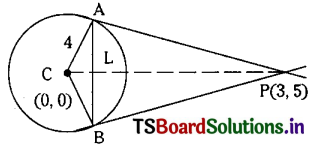
The given equation of a circle is x2 + y2 = 16
Centre C = (0, 0) and radius = 4
The equation of chord of contact of (3, 5) w.r.t. circle x2 + y2 = 16 is xx1 + yy1 – 16 = 0
⇒ 3x + 5y – 16 = 0
PL is the perpendicular distance from the point P(3, 5) to the chord AB.
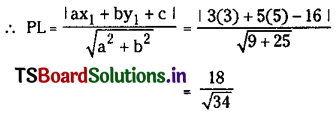
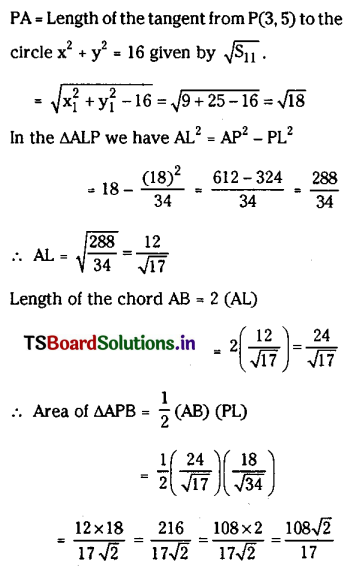
∴ Area of the triangle formed by the tangents and the chord of P = \(\frac{108 \sqrt{2}}{17}\) square units.
Question 4.
Find the locus of the point whose polar with respect to the circles x2 + y2 – 4x – 4y – 8 = 0 and x2 + y2 – 2x + 6y – 2 = 0 are mutually perpendicular.
Solution:
Let P(x1, y1) be the locus of the point whose polars w.r.t the given circles x2 + y2 – 4x – 4y – 8 = 0 ……(1) and x2 + y2 – 2x + 6y – 2 = 0 ……(2) are mutually perpendicular.
Polar of P(x1, y1) w.r.t circle (2) is xx1 + yy1 – (x + x1) + 3(y + y1) – 2 = 0
⇒ x(x1 – 1) + y(y1 – 3) – (x1 – 3y1 + 2) = 0 ………(3)
Polar of P(x1, y1) w.r.t circle (1) is xx1 + yy1 – 2(x + x1) – 2(y + y1) – 8 = 0
⇒ x(x1 – 2) + y(y1 – 2) – (2x1 + 2y1 + 8) = 0 ………(4)
Slope of (3) is \(-\left(\frac{x_1-1}{y_1+3}\right)\)
and slope of (4) is \(\left(\frac{x_1-2}{y_1-2}\right)\)
If (3) and (4) are mutually perpendicular then
\(\left(\frac{x_1-1}{y_1+3}\right)\left(\frac{x_1-2}{y_1-2}\right)\) = -1
⇒ \(\left(x_1^2-3 x_1+2\right)=-\left(y_1^2+y_1-6\right)\)
⇒ \(x_1^2+y_1^2-3 x_1+y_1-4=0\)
∴ Locus of P(x1, y1) is x2 + y2 – 3x + y – 4 = 0.
![]()
Question 5.
Find the locus of the foot of the perpendicular drawn from the origin to any chord of the circle S ≡ x2 + y2 + 2gx + 2fy + c = 0 which subtends a right angle at the origin.
Solution:
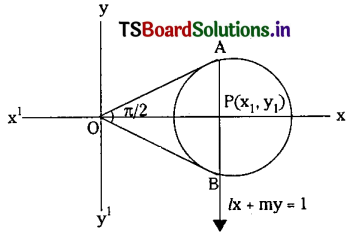
Any chord of the circle may be taken as lx + my = 1 ………(1)
Given equation of circle is x2 + y2 + 2gx + 2fy + c = 0 ………(2)
Chord (1) subtends a right angle at the origin.
Hence the lines joining the origin to the points of intersection of (1) and (2) are obtained by homogenizing equation (2) with equation (1).
From (1), lx + my = 1
and from (2), x2 + y2 + (2gx + 2fy)(1) + c(1)2 = 0
⇒ x2 + y2 + (2gx + 2fy) (lx + my) + c(lx + my)2 = 0
⇒ x2 + y2 + (2glx2 + 2fy2m + 2flm + 2gmxy) + c(l2x2 + 2lmxy + m2y2) = 0
⇒ (1 + 2gl + cl2) x2 + (1 + 2fm + cm2)y2 + xy(2fl + 2gm + 2lmc) = 0
This is a homogenizing second-degree equation that represents pair of lines OA and OB passing through the origin. If these lines are perpendicular then
the coefficient of x2 + coefficient of y2 = 0.
⇒ 1 + 2gl + 1 + cl2 + 2fm + cm2 = 0
⇒ c(l2 + m2) + 2(gl + fm) + 2 = 0 ……….(3)
From (1), the equation of the line perpendicular to the chord is mx – ly = 0 ………..(4)
Solving lx + my = 1 …..(1) and mx – ly = 0 ………(4)
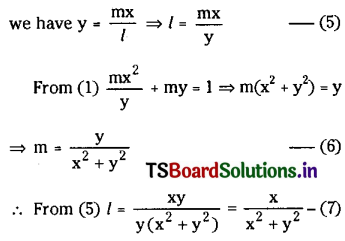
To find the locus of the foot of the perpendiculars we have to eliminate ‘l’ and ‘m’.
Substituting these values of l and m in (3), we get
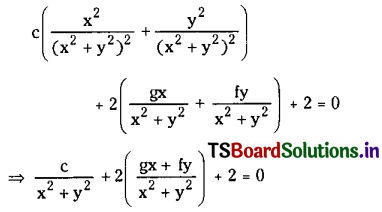
⇒ c + 2(gx + fy) + 2(x2 + y2) = 0
⇒ 2(x2 + y2) + 2(gx + fy) + c = 0
∴ Locus of the foot of the perpendiculars drawn from the origin to any chord of circle S ≡ x2 + y2 + 2gx + 2fy + c = 0 which subtends a right angle at the origin is 2(x2 + y2) + 2(gx + fy) + c = 0.